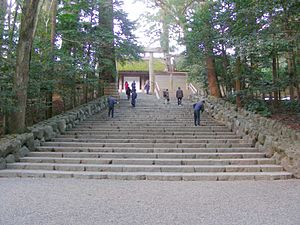Ten'an facts for kids
Ten'an (error: {{nihongo}}: Japanese or romaji text required (help)) was a special time period in Japanese history. It's like how we have years, but in old Japan, they also used "era names" called nengō (年号, ([nengō,] Error: {{nihongo}}: text has italic markup (help), lit. "year name")). The Ten'an era came after the Saikō era and before the Jōgan era. This period started in February 857 and ended in April 859. During these years, two emperors ruled Japan: Emperor Montoku and Emperor Seiwa.
Important Events During Ten'an
During the Ten'an era, some big changes happened in the leadership of Japan.
- September 27, 858 (in the second year of Ten'an): Emperor Montoku passed away. After his death, his oldest son, Prince Korehito, became the new emperor. This process is called "succession." He officially took on the role and duties of the emperor in special ceremonies. He became known as Emperor Seiwa. His new rule was announced at important places like the Ise Shrine and at the tombs of past emperors.
- December 15, 858 (also in the second year of Ten'an): Emperor Seiwa was still very young. Because of this, his grandfather, Fujiwara no Yoshifusa, was chosen to be his "regent." A regent is like a temporary leader who helps the emperor make important decisions until the emperor is old enough to rule by himself.
Related Information
- Heian period: This was a long period in Japanese history that included the Ten'an era.
- You can learn more about the Japanese calendar and its history from the National Diet Library here.

All content from Kiddle encyclopedia articles (including the article images and facts) can be freely used under Attribution-ShareAlike license, unless stated otherwise. Cite this article:
Ten'an Facts for Kids. Kiddle Encyclopedia.

